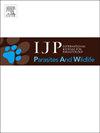欧亚狼(Canis lupus lupus)的高流行率:第三代测序解决了混合感染
IF 2.2
3区 医学
Q3 ECOLOGY
International Journal for Parasitology-Parasites and Wildlife
Pub Date : 2025-09-22
DOI:10.1016/j.ijppaw.2025.101140
引用次数: 0
摘要
肉孢子虫属(顶复合体:球虫)是专性异种原生动物,感染范围广泛的宿主物种。传播遵循捕食者-猎物循环,涉及中间宿主(IH)和最终宿主(DH)。对于许多物种来说,只有his被确定,而DHs仍然未知。DHs可同时感染多种肉囊菌,这使物种鉴定变得复杂。我们的目的是确定在瑞士自由放养的狼中肌囊虫感染的流行率和物种多样性,同时使用coproology和分子方法。进一步的目标是评估第三代测序在解决混合感染方面的效用。2017 - 2023年共采集87份狼肠道内容物样本,采用沉淀-浮选法进行粪镜分析。76%(66/87)检出结节性卵囊/孢子囊。66份阳性样本中有57份获得了DNA,其中55份在Sarcocystis 18S rRNA筛选PCR中呈阳性。此外,对线粒体细胞色素c氧化酶亚基I (COI)基因进行了PCR和实时PCR检测。将常规PCR的PCR产物提交Sanger测序。16%(9/55)的样本存在单一感染,84%(46/55)的样本存在混合感染。通过第三代测序(Pacific Biosciences)对5个样本的18S rRNA全长和COI片段PCR产物进行分析。BLAST和系统发育分析验证了分类分类。分子分析鉴定出9种已知的肉囊菌:S. tenella、S. arieticanis、S. capreolicanis、S. linearis、S. gracilis、S. cruzi、S. capracanis、S. iberica和S. venatoria。新开发的第三代测序数据管道为混合感染样本提供了高分辨率的物种水平鉴定。这些发现首次证实了欧亚狼是多种肉囊菌的天然DH,包括线性肉囊菌、伊比利亚肉囊菌和venatoria肉囊菌。需要进一步对猎物种类进行补充研究,以阐明宿主-寄生虫动力学。本文章由计算机程序翻译,如有差异,请以英文原文为准。

High prevalence of Sarcocystis spp. in the Eurasian wolf (Canis lupus lupus): Third-generation sequencing resolves mixed infections
Sarcocystis spp. (Apicomplexa: Coccidia) are obligate heteroxenous protozoa that infect a wide range of host species. Transmission follows a predator-prey cycle involving an intermediate host (IH) and a definitive host (DH). For many species, only IHs have been identified, while DHs remain unknown. DHs can be infected with multiple Sarcocystis spp. at the same time, which complicates species identification. We aimed to determine the prevalence and species diversity of Sarcocystis infections in free-ranging wolves in Switzerland using both coprological and molecular methods. A further goal was to evaluate the utility of Third-generation sequencing for resolving mixed infections. A total of 87 wolf intestinal content samples were collected between 2017 and 2023 and analyzed coproscopically by a sedimentation-flotation method. Sarcocystis oocysts/sporocysts were detected in 76 % (66/87). DNA was obtained from 57/66 positive samples and 55/57 resulted positive in a Sarcocystis 18S rRNA screening PCR. Additionally, mitochondrial cytochrome c oxidase subunit I (COI) gene PCR and a real-time PCR targeting S. cruzi were performed. PCR products from conventional PCRs were submitted for Sanger sequencing. Monoinfections were identified in 16 % (9/55) and mixed infections in 84 % (46/55) of the samples. A subset of five samples was analyzed by Third-generation sequencing (Pacific Biosciences) of the 18S rRNA full-length and COI fragment PCR products. BLAST and phylogenetic analysis were used to validate taxonomic classification. Molecular analysis identified nine known Sarcocystis species: S. tenella, S. arieticanis, S. capreolicanis, S. linearis, S. gracilis, S. cruzi, S. capracanis, S. iberica, and S. venatoria. Newly developed pipelines for the Third-generation sequencing data provided high-resolution species-level identification in samples with mixed infections. These findings confirm the Eurasian wolf as natural DH for multiple Sarcocystis species for the first time, including S. linearis, S. iberica, and S. venatoria. Further complementary studies on prey species are needed to clarify host-parasite dynamics.
求助全文
通过发布文献求助,成功后即可免费获取论文全文。
去求助
来源期刊

International Journal for Parasitology-Parasites and Wildlife
Medicine-Infectious Diseases
CiteScore
3.80
自引率
5.60%
发文量
113
审稿时长
45 days
期刊介绍:
The International Journal for Parasitology: Parasites and Wildlife (IJP-PAW) publishes the results of original research on parasites of all wildlife, invertebrate and vertebrate. This includes free-ranging, wild populations, as well as captive wildlife, semi-domesticated species (e.g. reindeer) and farmed populations of recently domesticated or wild-captured species (e.g. cultured fishes). Articles on all aspects of wildlife parasitology are welcomed including taxonomy, biodiversity and distribution, ecology and epidemiology, population biology and host-parasite relationships. The impact of parasites on the health and conservation of wildlife is seen as an important area covered by the journal especially the potential role of environmental factors, for example climate. Also important to the journal is ''one health'' and the nature of interactions between wildlife, people and domestic animals, including disease emergence and zoonoses.
 求助内容:
求助内容: 应助结果提醒方式:
应助结果提醒方式:


